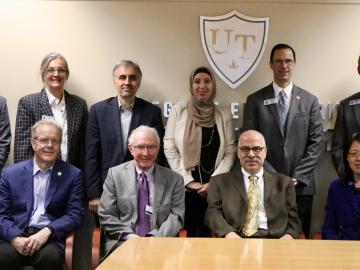
Filter News
Area of Research
- Advanced Manufacturing (6)
- Biology and Environment (17)
- Computational Biology (1)
- Computational Engineering (2)
- Computer Science (5)
- Energy Science (41)
- Fuel Cycle Science and Technology (1)
- Fusion and Fission (14)
- Fusion Energy (8)
- Isotope Development and Production (1)
- Isotopes (2)
- Materials (68)
- Materials Characterization (1)
- Materials for Computing (13)
- Materials Under Extremes (1)
- National Security (10)
- Neutron Science (19)
- Nuclear Science and Technology (18)
- Nuclear Systems Modeling, Simulation and Validation (2)
- Sensors and Controls (1)
- Supercomputing (35)
- Transportation Systems (1)
News Type
News Topics
- (-) Advanced Reactors (25)
- (-) High-Performance Computing (44)
- (-) Machine Learning (27)
- (-) Materials Science (90)
- (-) Nuclear Energy (47)
- (-) Polymers (23)
- (-) Quantum Computing (18)
- (-) Security (13)
- 3-D Printing/Advanced Manufacturing (82)
- Artificial Intelligence (51)
- Big Data (25)
- Bioenergy (42)
- Biology (47)
- Biomedical (28)
- Biotechnology (14)
- Buildings (36)
- Chemical Sciences (48)
- Clean Water (16)
- Composites (23)
- Computer Science (105)
- Coronavirus (28)
- Critical Materials (23)
- Cybersecurity (20)
- Education (3)
- Element Discovery (1)
- Emergency (1)
- Energy Storage (75)
- Environment (86)
- Exascale Computing (14)
- Fossil Energy (2)
- Frontier (17)
- Fusion (26)
- Grid (38)
- Hydropower (6)
- Irradiation (2)
- Isotopes (25)
- ITER (5)
- Materials (96)
- Mathematics (3)
- Mercury (5)
- Microelectronics (1)
- Microscopy (28)
- Molten Salt (8)
- Nanotechnology (41)
- National Security (21)
- Neutron Science (81)
- Partnerships (33)
- Physics (30)
- Quantum Science (42)
- Simulation (19)
- Space Exploration (13)
- Statistics (2)
- Summit (30)
- Transportation (62)
Media Contacts

OAK RIDGE, Tenn., Feb. 19, 2020 — The U.S. Department of Energy’s Oak Ridge National Laboratory and the Tennessee Valley Authority have signed a memorandum of understanding to evaluate a new generation of flexible, cost-effective advanced nuclear reactors.

An international team of researchers has discovered the hydrogen atoms in a metal hydride material are much more tightly spaced than had been predicted for decades — a feature that could possibly facilitate superconductivity at or near room temperature and pressure.

Rigoberto “Gobet” Advincula has been named Governor’s Chair of Advanced and Nanostructured Materials at Oak Ridge National Laboratory and the University of Tennessee.

Nuclear scientists at Oak Ridge National Laboratory have established a Nuclear Quality Assurance-1 program for a software product designed to simulate today’s commercial nuclear reactors – removing a significant barrier for industry adoption of the technology.

Researchers at Oak Ridge National Laboratory demonstrated that an additively manufactured polymer layer, when applied to carbon fiber reinforced plastic, or CFRP, can serve as an effective protector against aircraft lightning strikes.

As scientists study approaches to best sustain a fusion reactor, a team led by Oak Ridge National Laboratory investigated injecting shattered argon pellets into a super-hot plasma, when needed, to protect the reactor’s interior wall from high-energy runaway electrons.

If humankind reaches Mars this century, an Oak Ridge National Laboratory-developed experiment testing advanced materials for spacecraft may play a key role.

The U.S. Department of Energy announced funding for 12 projects with private industry to enable collaboration with DOE national laboratories on overcoming challenges in fusion energy development.

ORNL and The University of Toledo have entered into a memorandum of understanding for collaborative research.

In a recent study, researchers at Oak Ridge National Laboratory performed experiments in a prototype fusion reactor materials testing facility to develop a method that uses microwaves to raise the plasma’s temperature closer to the extreme values


